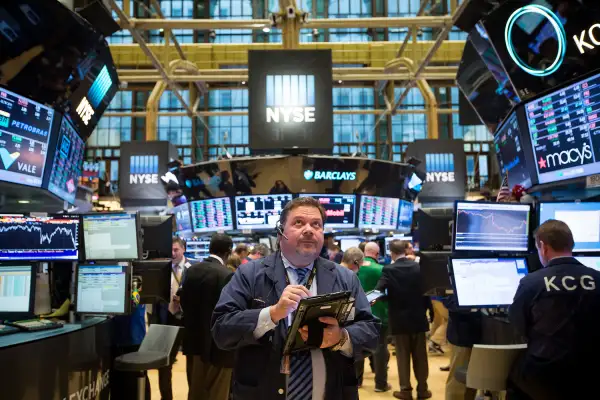7 Numbers That Put This Market Madness In Perspective
Money is not a client of any investment adviser featured on this page. The information provided on this page is for educational purposes only and is not intended as investment advice. Money does not offer advisory services.

If you've been paying attention to the frantic stock market headlines—or doing your best to ignore them—you know about the recent carnage on Wall Street.
Both the Dow Jones industrial average and Standard & Poor's 500 index were down more than 9% so far this year when trading began today. And both major U.S. stock indexes were off around 13% from their May 2015 highs, which means that domestic equities are officially in a "correction," defined as a loss of at least 10%.
But here are some important numbers that may be less familiar—and can help you put the market's wild gyrations into perspective.
14,650
This is the level that the Dow Jones industrial average would have to fall below to trigger an official bear market, which is defined as a drop of 20% or more. As of Wednesday's close, the Dow stood at 15,766.
The last time the Dow traded below 14,650 was in 2013, when the economy was still working through the aftermath of the global financial crisis.
1,705
This is the level the S&P 500 would have to sink to for it to be snared by the bear. The benchmark index closed on Wednesday at 1,859. The last time the S&P 500 fell to these levels was in 2014.
1.67%
This was the lowest yield for 10-year Treasuries last year; right now it's 1.97%. Why look at bonds when the stock market is sinking? Often, stock investors look to what the bond market is doing to seek confirmation of their own fears.
If the 10-year Treasury yield dips below its 2015 lows, that would suggest that fixed-income investors are more scared than they were during last year's worst panic — a sign this could be the bear market everyone is waiting for.
$36
Crude oil prices dipped to below $27 a barrel on Wednesday, triggering the panic on Wall Street. A good deal of the drop has to do with the glut of oil on the market, especially now that economic sanctions on Iran have been lifted, potentially adding to supplies. But economists are equally worried about the state of future demand for oil, especially as China's economic growth slows more quickly than expected.
In the U.S., it costs roughly $36 a barrel to produce a barrel of crude oil, compared to more than $40 a barrel in Canada and nearly $50 a barrel in Brazil. If crude oil were to climb back above $36, it would support the prospects of the U.S. energy sector, which has been a drag to corporate profit growth in the S&P 500. Oil above $36 would also go a long way toward reassuring U.S. investors that the domestic economy is unlikely to slip into recession anytime soon.
2
Heading into the year, the Federal Reserve looked as if it might raise short-term interest rates modestly four times this year, as part of its gradual effort to "normalize" interest rates given the expanding U.S. economy.
But the market sell-off may put a crimp in the Fed's plans. "The stock market clearly views four rate hikes as too much too fast," noted Ed Yardeni, president and chief investment strategist at Yardeni Research. Fed officials "should be starting to have second thoughts about hiking rates again," he added, "especially given the unrelenting rout in stock prices and the free-falling price of oil."
A January survey by Bank of America Merrill Lynch found that a majority of fund managers now think that the Fed will hike rates only twice this year, and a growing number think there could be only one rate increase in 2016.
If the Fed were to telegraph that change in mindset, it could help the markets recover. European Central Bank president Mario Draghi hinted at the possibility of yet more stimulus for the Eurozone, lifting the European markets.
12%
The $64,000 question is whether the U.S. is headed for a recession or not. Why? In most cases, bear markets in stocks foreshadow a recession in the real economy that's either begun or is about to start in the coming weeks or months.
Yet only 12% of fund managers surveyed by Bank of America Merrill Lynch believe this economy is likely to go into reverse in the next 12 months.
That's key. Major sell-offs that didn’t precede recessions have averaged losses of around 20%. That pales in comparison to the 50% or greater losses in the last two bear markets. And bear markets that don't foreshadow a recession typically last only seven months, far shorter than most bears.
40
In past market panics, the CBOE Volatility Index approaches or climbs above a reading of 40. That’s roughly double the historic level. But on Wednesday, when the Dow fell as much as 566 points at one point in the day, the so-called "fear index" closed at less than 28.
So there's hope yet.
